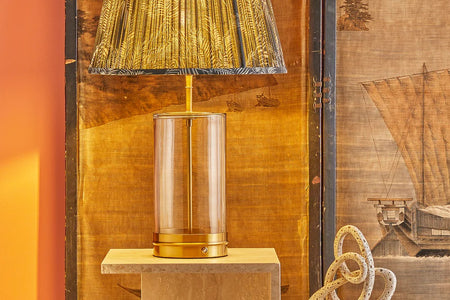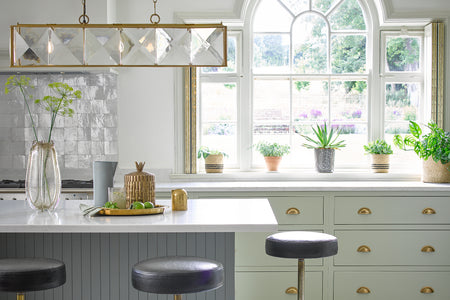Struggling with a tricky dark corner or a low ceiling? Allow us to share our lighting expertise...
Whether it’s a lack of natural light, low ceilings, or a general shortage of warmth and atmosphere, we take a look at some of the most common home lighting problems and what you can do to help overcome them…
Home lighting problem #1: A lack of natural light
Natural light is a great thing to have – but if your home just doesn’t seem to have quite enough of the stuff, you can still make your space look and feel bright and airy with some carefully chosen lighting. The key is to use a range of different light sources and to layer your lighting.
A glass pendant light or chandelier will create a gorgeous focal point in a room, and will reflect ambient light around the space beautifully (even when it’s switched off). You can supplement your overhead lighting with some glass and brass wall lights, while a set of floor and table lamps will provide task and accent lighting. Choose reflective materials and finishes, such as glass, metallics and light or shiny fabrics, plus some strategically placed mirrors, to help maximise the effect.
Discover more tips for dealing with a lack of natural light, in our guide: How to boost the natural light in your home.
 This hallway by Clare Weeks of My-Studio.maximises the natural lighti with Pooky's Bulbus and Crescent lights, plus mirrors and bright reflective neutrals. Image: My-Studio
This hallway by Clare Weeks of My-Studio.maximises the natural lighti with Pooky's Bulbus and Crescent lights, plus mirrors and bright reflective neutrals. Image: My-Studio
Home lighting problem #2: Low ceilings
Low ceilings can make a room feel dark and enclosed. When lighting a room with low ceilings, you should aim for an even, balanced spread of light. Avoid using large or low-hanging pendant lights, which will draw attention to the ceiling and make the space seem smaller. Instead, a set of matching wall lights will provide a lovely warm, ambient light: an uplighter style of wall light will wash the light upwards and help to emphasise the wider space. Meanwhile, a set of designer floor lamps will highlight the vertical space and add the illusion of height, while helping to banish any dark corners.
For more ideas, see our guide: How to light a room with low ceilings.  An uplighter (pointy-uppy) style wall light like the Cagney is a perfect lighting solution if you have low ceilings
An uplighter (pointy-uppy) style wall light like the Cagney is a perfect lighting solution if you have low ceilings
Home lighting problem #3: A lack of warmth and atmosphere
Lighting can play a big role in how a space feels, as well as how it looks – and it’s not just down to your light fittings. If your space feels cold or lacking in atmosphere, it’s also important to consider the type of lightbulbs you are using. Different types of light can have ‘warm’ or ‘cold’ qualities, with bluish-white light appearing colder and more stimulating, while yellow-white light is warmer and more relaxing.
The quality of the light emitted from a lightbulb is known as its ‘colour temperature’ and is measured on the Kelvin scale (K). The lower down the scale, the warmer the light: so for places where you want to relax, such as the living room, dining room or bedroom, you should aim for lighting at the lower end of the scale – around 2,500-3,000K.
Strategically placing a series of warm-bulbed table lamps and floor lamps around a room will cosy the place up in no time.
Find out more about warm lighting here: Understanding warm lighting - plus a guide to colour temperature.
 The Phileas rechargeable table lamp is cordless, so you can place it anywhere for lovely, warm, cosy light
The Phileas rechargeable table lamp is cordless, so you can place it anywhere for lovely, warm, cosy light
Home lighting problem #4: Lighting a large open plan space
Open plan spaces can be fabulous places, but they can pose a challenge when it comes to making them feel homely. You can help to make a large, open plan space feel comfortable and inviting by using lighting to create different zones within the space.
Even in an open plan set-up, each area will have its own specific lighting needs. For example, the kitchen area will need plenty of strong, practical task lighting, while the dining and living zones will need to include some lower-level mood lighting. By creating different lighting zones, and using a range of light sources, you can help to delineate each area and give it both purpose and personality.
Read more about zoning in our guide: Open plan living: How to use lighting to create different zones in your home.

Home lighting problem #5: Eliminating shadows and dark areas
Shadows can be a real challenge in some areas of the home. When lighting a space, you should always try to position your lights with a view to eradicating unwanted shadows and gloomy areas.
Downlights and recessed lights can be a particular issue in areas such as kitchens and bathrooms. While they provide plenty of direct overhead lighting, they can also result in some areas being insufficiently lit or cast into shadow. In a kitchen it’s important to have a good balance of light, with plenty of task lighting for working areas such as the counters, the cooker and the sink.
Meanwhile, in a bathroom a bright overhead light is not only impractical, but can also cause rather unflattering shadows! A pair of wall lights placed at eye level either side of the mirror will help to eliminate shadows and provide plenty of practical light.
Find out more about lighting some of those more challenging spaces in our guide: Lighting for the tricky areas of your home.
 A tricky little bathroom made beautiful by Anna Haines - featuring Pooky's Stanley wall light. Photo: Andrew Steel.
A tricky little bathroom made beautiful by Anna Haines - featuring Pooky's Stanley wall light. Photo: Andrew Steel.
Find lots more lighting tips in the All About Lighting section of our blog, and browse our full range of beautiful, affordable lighting here.
See also:
Five common lighting mistakes – and how to avoid them;
6 kitchen lighting mistakes and how to avoid them











